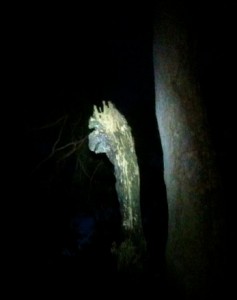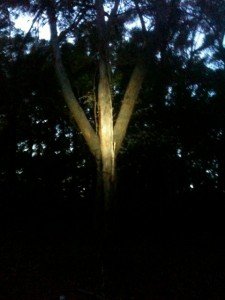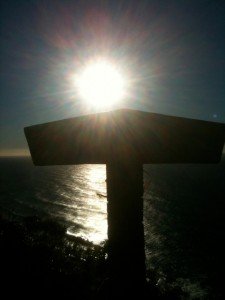 (All photos in this article by Donovan)
(All photos in this article by Donovan)
One of the simplest ways to make for a powerful ritual experience is also one of the most seemingly trivial: incorporate walking into the process.
Picture this: you drive to someone’s house. Everyone wanders in, and it feels like just any other kind of occasion. There isn’t an opportunity to gradually shift gears, and so when the proceedings start it really doesn’t feel that special, because the immediately surrounding activities and setting are so familiar, so everyday.
After the ritual, which never really takes off and feels sort of…ill fitting…you all hunker down for nibbles and chats. Maybe beer or coffee, depending on your predilection. Talk about (gods forbid) TV shows or other trivia ensues. No one is brave enough to break out of the social scripts implied by the situation to talk about anything spiritual, personal, or magical. The external observer wouldn’t have much to go on if asked to distinguish this from any other typical, slightly boring, dinner party.
It is hard to shift one’s consciousness into a liminal, reverent state when all the trappings of the moment are completely everyday.
Ok, now picture this:
In the darkness of early morning you arrive at the edge of the forest. Waiting for your fellow participant you count the twinkling stars and grin with delight when a huge falling star pierces the sky. Distantly down the hill, through the trees, you see headlights approach. It has to be the friend you intend to do this with…and indeed it is.
Perfunctory greetings done, you equip yourselves with torches and bags and plunge into the forest, hiking up rugged paths through the gnarled trees. To the right is a cliff face and the vast, moon-kissed majesty of the ocean, the infinite patterns of the waves as hypnotic as the sound of its perpetual assault on the rocks and cliffs. To the right, ancient trees, doughty boulders, the hidden movement of nocturnal beasts.
You move at a cracking pace, legs pumping, arms swaying. It feels really good to use your flesh in this way, to feel the bones and muscles working together just as they were made to. Then the forest opens out, and you flit through more open terrain, no other humans within miles. You marvel at the evocative shapes of the trees, the way that the nightside forest opens vast portals into your imagination. Eons of ancestral conditioning – pre-human instincts – well up in this primal environment, your senses drinking in each moment, seeing personality and intention and spirit in every branch, the sway of every leaf.
And as you walk – twenty minutes, then thirty, then an hour – the two of you talk. About your hopes, your struggles, your victories and set backs. And always these word-songs are set in the key of the purpose of the blot that awaits. This time – a rite for Spring and Victory. Words become your door out of the circuits and mazes of mun-daily thinking patterns and habits. The blows of life’s stressors drain away as your recover your sense of horizon, creativity, hope.
 All too soon the first hint of daylight is creeping up as you come to the sacred place. It is marked by two trees – from the correct angle, they form an Elhaz rune shape – concealing and revealing the site all at once. You plunge off the path, and soon stand on a vast flat boulder that perches on a cliff face. Below you – thick forest. Beyond – endless ocean, as far as you can see from north to south. The horizon is rimmed with morning cloud and the faintest hint of gold is beginning to spill over the edge of the world.
All too soon the first hint of daylight is creeping up as you come to the sacred place. It is marked by two trees – from the correct angle, they form an Elhaz rune shape – concealing and revealing the site all at once. You plunge off the path, and soon stand on a vast flat boulder that perches on a cliff face. Below you – thick forest. Beyond – endless ocean, as far as you can see from north to south. The horizon is rimmed with morning cloud and the faintest hint of gold is beginning to spill over the edge of the world.
You sit and sing and chant Sowilo – the sun rune – to honour her as she spreads her shimmering majesty out across the billowing silk of the sea. Her rays soak into your flesh and your senses are swarmed with scintillating colour; the raucous celebration of bird song; the fresh cool scents of earth, moss, and dew.
Somehow the ritual urge slowly takes hold. First – food and drink offered in a hollow. Then your companion disappears, returning to your amazement with a rescued ritual artefact thrown wildly off the cliff and into the trees last time you came here.
 Then…gradually speech turns from casual laughter to serious laughter, as gods and good tidings are invoked. Sweet, sweet home-brewed mead is poured. Oaths and prayers are made good in the drafts that are downed. Spells spoken for yourselves and for others and for the very place itself. Loaded phrases swirl and coalesce: “bottoms up” becomes the seed of the day, a meme loaded with meaning ineluctable. When finally the tide of the magic is spent mead is poured to the ground, offered freely and with deep gratitude.
Then…gradually speech turns from casual laughter to serious laughter, as gods and good tidings are invoked. Sweet, sweet home-brewed mead is poured. Oaths and prayers are made good in the drafts that are downed. Spells spoken for yourselves and for others and for the very place itself. Loaded phrases swirl and coalesce: “bottoms up” becomes the seed of the day, a meme loaded with meaning ineluctable. When finally the tide of the magic is spent mead is poured to the ground, offered freely and with deep gratitude.
Overflowing with joy, you linger at the site, gnawing on fresh, whole foods and marvelling at the profound beauty of this place. In no hurry, bags are packed, thanks are said, synchronicities are noted (the arrival of a giant dragonfly, a novelty in these parts, seems a direct symbolic answer to at least one of the incantations sung).
You walk back again at pace, through the white-gold early morning light, the forest only just edging into a hint of wakefulness. Renewed, you feel your place in the scheme of wyrd reforged, hearts and minds restored. Spring has been found and marked and wondered at and invoked without greed into the unfolding tale of each of your lives.
Tell me – which one of these scenarios do you prefer? Because to me there is something magic about celebrating one’s spirituality in places – natural places – you can only get to on foot. Something perfect about releasing all the trappings into which daily life compresses us by turning over to the rhythm of footsteps. Of having the time and space to use conversation to pour out all the gunk in which life smothers us. Of being immersed in nature, in places where imagination is active, alive, sovereign.
 It doesn’t seem accidental that the early Heathens built no temples, but held their religious observances in groves and clearings and deep in the woods. In elder times people perhaps understood far more consciously the power and practical need of deep spiritual experiences, and perhaps their choices of location for making their offerings and prayers reflected this understanding.
It doesn’t seem accidental that the early Heathens built no temples, but held their religious observances in groves and clearings and deep in the woods. In elder times people perhaps understood far more consciously the power and practical need of deep spiritual experiences, and perhaps their choices of location for making their offerings and prayers reflected this understanding.
The luxury of such adventures as the one described here is not always available – Donovan and I don’t get to do this sort of thing nearly as much as we’d like. But hands down our little celebrations are to me far more spiritual, powerful, compelling, than even the most grandiose group gatherings I’ve attended, and it’s because we give ourselves over to the task at hand so completely. We take ourselves right outside of the comfortable bounds of life and belief and self-concept and the usual places in which our lives are lived. We go beyond all that in order to touch the sacred, to bring it back with us, to sprout into new life. And isn’t that what devotion – reverence – is all about?